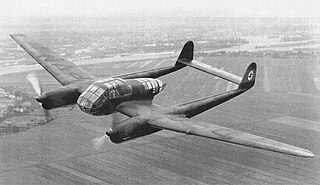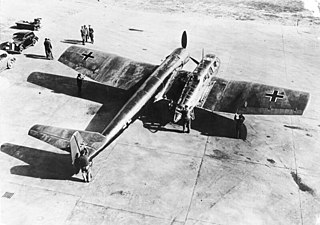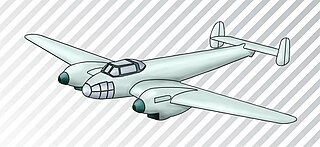
The Focke-Wulf Fw 200 Condor, also known as Kurier to the Allies, is a German all-metal four-engined monoplane originally developed by Focke-Wulf as a long-range airliner. A Japanese request for a long-range maritime patrol aircraft led to military versions that saw service with the Luftwaffe as long-range reconnaissance and anti-shipping/maritime patrol bomber aircraft. The Luftwaffe also made extensive use of the Fw 200 as a transport aircraft.

The Messerschmitt Me 210 was a German heavy fighter and ground-attack aircraft of World War II. Design started before the war, as a replacement for the Bf 110. The first examples were ready in 1939, but they proved to have unacceptably poor flight characteristics due to serious wing planform and fuselage design flaws. A large-scale operational testing program throughout 1941 and early 1942 did not cure the type's problems. The design entered limited service in 1942, but was soon replaced by the Messerschmitt Me 410 Hornisse, a further development of the Me 210. The failure of the Me 210's development program meant the Luftwaffe was forced to continue operating the Bf 110 after it had become outdated, despite mounting losses.

The Messerschmitt Bf 110, often known unofficially as the Me 110, is a twin-engined Zerstörer, fighter-bomber, and night fighter (Nachtjäger) developed in Nazi Germany in the 1930s and used by the Luftwaffe during World War II. Hermann Göring was a proponent of the Bf 110, believing its heavy armament, speed, and range would make the Bf 110 the Luftwaffe’s premier offensive fighter. Early variants were armed with two MG FF 20 mm cannon, four 7.92 mm MG 17 machine guns, and one 7.92 mm MG 15 machine gun for defence. Development work on an improved type to replace the Bf 110 - the Messerschmitt Me 210 - began before the war started, but its shakedown troubles resulted in the Bf 110 soldiering on until the end of the war in various roles. Its intended replacements, the aforementioned Me 210 and the significantly improved Me 410 Hornisse, never fully replaced the Bf 110.

The Focke-Wulf Fw 187 Falke ("Falcon") was a German aircraft developed in the late 1930s. It was conceived by Kurt Tank as a twin-engine, high-performance fighter, but the Luftwaffe saw no role for the design, perceiving it as intermediate between the Messerschmitt Bf 109 and Bf 110. Later prototypes were adapted to two-seats to compete with the Bf 110 in the heavy fighter (Zerstörer) role, but only nine aircraft were built in total.

The Arado Ar 240 was a German twin-engine, multi-role heavy fighter aircraft, developed for the Luftwaffe during World War II by Arado Flugzeugwerke. Its first flight was in 1940, but problems with the design hampered development, and it remained only marginally stable throughout the prototype phase. The project was eventually cancelled, with the existing airframes used for a variety of test purposes.

The Focke-Wulf Fw 189 Uhu is a German twin-engine, twin-boom, three-seat tactical reconnaissance and army cooperation aircraft. It first flew in 1938, entered service in 1940 and was produced until mid-1944.

The Blohm & Voss BV 138Seedrache, but nicknamed Der Fliegende Holzschuh was a World War II German trimotor flying boat that served as the Luftwaffe's main seaborne long-range maritime patrol and naval reconnaissance aircraft.

The Blohm & Voss BV 141 was a World War II German tactical reconnaissance aircraft, notable for its uncommon structural asymmetry. Although the Blohm & Voss BV 141 performed well, it was never ordered into full-scale production, for reasons that included the unavailability of the preferred engine and competition from another tactical reconnaissance aircraft, the Focke-Wulf Fw 189.

The Henschel Hs 127 was a German bomber that was built as two prototypes, but cancelled without entering mass production.

The Messerschmitt Bf 162 was a light bomber aircraft designed in Germany prior to World War II, which flew only in prototype form.

The Focke-Wulf Fw 191 was a prototype German bomber of World War II, as the Focke-Wulf firm's entry for the Bomber B advanced medium bomber design competition. Two versions were intended to be produced, a twin-engine version using the Junkers Jumo 222 engine and a four-engine variant which was to have used the smaller Daimler-Benz DB 605 engine. The project was eventually abandoned due to technical difficulties with the engines.

The Heinkel He 45 was a light bomber produced in Germany in the early 1930s, one of the first aircraft adopted by the newly formed Luftwaffe. Its appearance was that of a conventional biplane and included seating for pilot and gunner in tandem, open cockpits. Developed in parallel with the He 46, it appeared in 1931 as a general-purpose biplane and was employed mainly as a trainer, but was also used by the Luftwaffe for reconnaissance and light bombing duties. Production of this plane totalled 512 aircraft, including those built under licence by Gotha, Focke-Wulf, and BFW.

The Henschel Hs 124 was a twin-engine heavy fighter, attack aircraft and light bomber designed in Nazi Germany. After two prototypes had been built, work on the project was cancelled.

The Focke-Wulf Fw 42 was a design for a twin-engined medium bomber, of canard configuration, that was designed by Focke-Wulf Flugzeugbau AG in Germany in the early 1930s. Several air forces expressed interest in the aircraft. However, despite its advanced design being proven sound in wind tunnel testing, the Fw 42 failed to win a contract for development, and no examples of the type were ever built.
The Dornier Do 29 was a proposed zerstörer, or heavy fighter, designed by Dornier as a competitor to the Messerschmitt Bf 110.

The Focke-Wulf Fw 56 Stösser was a single-engine, parasol monoplane advanced trainer, built in the 1930s in Germany.

The Arado Ar 76 was a German aircraft of the 1930s, designed as a light fighter with a secondary role as an advanced trainer in mind.

The Focke-Wulf Fw 62 was a reconnaissance floatplane, designed and built by Focke-Wulf for use by Nazi Germany's Kriegsmarine. Only four were built.

The Arado Ar 198 was a prototype reconnaissance aircraft, developed by Arado Flugzeugwerke, with backing from the Luftwaffe, who initially preferred it over the Blohm & Voss BV 141 and the Focke-Wulf Fw 189. However, when flight tests were carried out the aircraft performed poorly and did not impress the Luftwaffe. One aircraft was completed in 1938.
The Focke-Wulf Nr. 238 Fernkampfflugzeug was a four-engine strategic bomber developed by the German aeronautical company Focke-Wulf-Flugzeugbau AG in the early 1940s and remained at the project stage. Designed to the same specifications issued by the Reichsluftfahrtministerium (RLM) which led to the Focke-Wulf Ta 400 and Junkers Ju 390, its development was cancelled by the RLM.



















